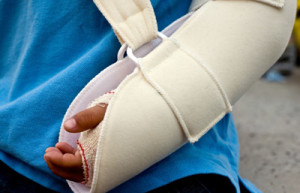 Summertime is here, which means that you and your family will be outside and more active in the warm weather. Kids, especially, will test their limits and some will end up with fractures, or broken bones. From the playground to riding a bike to jumping rope, broken bones can happen with any physical activity. Most fractures occur to either the legs or arms.
Summertime is here, which means that you and your family will be outside and more active in the warm weather. Kids, especially, will test their limits and some will end up with fractures, or broken bones. From the playground to riding a bike to jumping rope, broken bones can happen with any physical activity. Most fractures occur to either the legs or arms.
Children’s bones are softer and “bend” more than an adult’s bones. When too much force is upon the bones, they will fracture. Children are constantly growing and getting use to their changing body, which can make them a bit unbalanced at times. Pair that with a high activity level or group sports, the likelihood of broken bones is quite high. Since children’s bones are still growing and are softer, they can suffer from different types of fractures than adults. Here are the various types of breaks that children can experience:
- Bend fractures occur when the bone is actually bent, not broken.
- Torus fractures occur when the bone is twisted and buckled, not broken.
- Greenstick fractures occur when only one side of the bone is broken.
- Complete fractures occur when the break is completely through the bone.
- Growth plate fractures occur when the break damages the growth plates at the end of the bone. If not corrected and monitored by the physician, your child’s bone can grow incorrectly.
- Displaced fractures occur when the broken bone is not in correct alignment.
- Non-displaced factures occur when the broken bone is in the proper alignment with the other bones.
- Compound, or Open, breaks occur when the broken bone has pierced through the skin.
- Non-compound, or Closed, breaks occur when the broken bone does not pierce the skin.
Identifying a broken bone when it is not a compound fracture, is key. If your child does not, or cannot, move the hurt limb that is a sign that there is a possible fracture. Also, look for swelling and signs that your child is in pain. Some children will still move about and act “normal” when in actuality their bone is fractured. It is always best to err on the side of caution and contact his pediatrician or, if a break is obvious, take him to the emergency room for care.
If you are searching for a pediatrician, go to IPALC.org for a list of physicians in the southwest Florida area.
Share on Facebook



 Southwest Florida Medicine.com is dedicated to bringing you the very best health information available today!
Subscribe or check back regularly!
Southwest Florida Medicine.com is dedicated to bringing you the very best health information available today!
Subscribe or check back regularly!